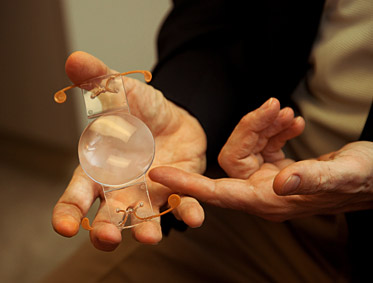Lens Implants
The natural lens of the eye is removed during cataract surgery and is replaced by an artificial lens implant. Our goal before surgery is to determine the lens that best meets your visual needs.
There are a variety of lens styles and materials available.
With the increase in lens options, patients are increasingly involved in selecting the lens implant type. For many years a standard single-focus implant was routinely used and reliably restored vision. Today there are additional options for those who wish to be less dependent on glasses. These newer, high-technology lenses require additional skill, care and services and there are additional costs associated with them.
Single Vision Lens Implants
A standard conventional, or monofocal, implant is designed to provide sharp focus and vision at one distance. Glasses are usually needed to provide distance at other tasks, such as for reading or for computer usage. These lenses are highly successful at restoring excellent vision and have been considered the standard for many years.
Lens Implants for Both Distance and Near Vision
It is now possible for many individuals to greatly reduce the need for glasses. As age 40 to 50 we routinely notice the need for additional lenses or glasses to provide focusing at different distances. This is the condition of presbyopia that occurs as the natural lens ages and becomes less flexible.
Several lens implants are now available that can correct this problem. They are specifically designed to provide enhanced vision at multiple distances. Our doctors usually prefer the Crystalens (by Bausch and Lomb) or the ReStor (by Alcon) to achieve this goal. These lenses work well for many, but are not for everyone. Careful discussion and examination are needed to determine appropriate candidates for such a lens. These lenses are require additional measurements, skill and services and are more expensive than standard implants. The additional costs are usually not covered by insurance but financing is available.
Astigmatism-Correcting Lens Implants (Toric Lens Implant)
Astigmatism is an optical abnormality usually occurring when the cornea is not spherical, but is somewhat more elliptical or football-shaped. This is conventionally treated by glasses or contact lenses but can now be corrected by customized Toric Lens Implants. The astigmatism is neutralized by the lens which is rotated precisely within the eye to align with the direction of the corneal curvature. This is highly effective at reducing astigmatism and therefore at improving vision after surgery, optimizing uncorrected vision and reducing the need for glasses.
Additional measurements and followup are required which are typically not covered by insurance.
